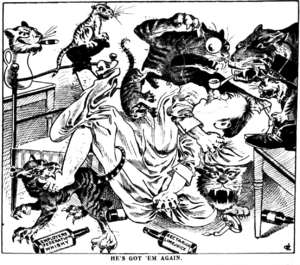J. H. Leonard facts for kids
Joseph John Henry Leonard (born around 1863 – died November 19, 1929) was a talented Australian artist who drew pictures for newspapers. His artwork first appeared in funny weekly newspapers in Adelaide. He signed his work in different ways, like "J. H. Leonard," "Leo," or just "JL."
Early Life and Art Career
Joseph Leonard was born in Gawler, South Australia. He was the youngest child of James C. Leonard, a church minister, and his second wife, Anne. Joseph went to schools run by his father in Bentley and Angaston. In July 1879, he started working for the government in the Colonial Architect's office. Joseph was an artist who taught himself. His uncle in London was also a successful painter, and sometimes Joseph signed his work in a similar way, which might have caused some confusion.
In 1880, Joseph won a prize for a drawing he made with India ink. He soon found that people really liked his pen-and-ink sketches, funny drawings (called caricatures), and prints (called lithographs). He sold his work to newspapers like the Port Adelaide News, The Lantern, Adelaide Punch, and Frearson's Weekly. Because his art was so popular, he felt confident enough to quit his government job. He became the main cartoonist for The Lantern, which had many great artists working there at the time.
Joseph also had other talents! He was a good singer with a light voice and a skilled actor. He performed with a group of people who acted for fun, called the Yorick Club. When they performed in bigger towns like Kapunda and Gawler, Joseph would entertain the audience by quickly drawing pictures of famous local people.
In 1886, he moved from Adelaide to work for Melbourne Punch, another newspaper.
In 1888, he created a famous oil painting that he displayed in a shop window in Melbourne. The painting made fun of a politician named Henry Parkes, comparing him to a sad king from a play. It showed how Joseph thought the economy in New South Wales was struggling.
Later, he moved to Sydney. By 1892, he was working for the Illustrated Sydney News. Joseph was known for drawing strong cartoons that criticized bankers during a difficult economic time in 1893.
Famous Artworks
Joseph Leonard's art could be found in many places. A wine bar in Rowe Street, Sydney called "The Mirror" was decorated with hundreds of his sketches of well-known people.
In December 1900, his drawing called Soldiers of the Queen was published in The Australian Field newspaper. This drawing, which showed men in different uniforms, was the very first colored artwork ever published in an Australian newspaper!
He also illustrated a series of books written by "A Vagabond" (whose real name was John Stanley James). Joseph drew a portrait of the author for the front of the book and many other drawings throughout the pages.
In 1901, Joseph took on a special challenge to show off his amazing drawing skills. He drew a portrait of the Duke and Duchess of Cornwall and York (who later became King George V and Queen Mary). This portrait, which was about 21 by 18 inches, was surrounded by Australian wildflowers and a decorative frame. The incredible part was that the entire drawing was made using only one continuous line! The line never broke or crossed itself, and its width changed to create light and shadows. It started at the tip of one nose and ended at the other. People said it was not only a fantastic demonstration of his penmanship but also an excellent drawing.
Some people believe that a cartoon called "He's Got 'em Again," published in The Brisbane Worker in 1906, was drawn by Leonard. This cartoon, which shows someone having "the horrors" (a term for seeing things that aren't there), was likely published in the New South Wales Worker. You can see his signature, an interlocked "JL," in the bottom right corner.
Joseph was also known for creating beautiful "illuminated addresses." These were special, decorated documents given as gifts to honor people. Some of the people who received these special addresses included:
- E. Kidgell, a sub-editor for The Sunday Times.
- H. M. Evans, who managed the companies that published The Sunday Times, The Referee, and The Arrow.
- Mr. Bates, a stationmaster in Mortdale.
- Dr. J. Eli Webb and nurses Palmer, Bantin, Bastin, and Grattin, who were honored for their hard work during the flu epidemic between 1917 and 1920.
- W. I. Donald, the Town Clerk of Hurstville, who had returned from the war.
- Ex-alderman Hugh Patrick, who received an address at the Masonic Hall in Hurstville.
Joseph often created these beautiful documents for free, simply out of respect for the people receiving them.
Later Life and Legacy
Around 1895, Joseph Leonard married Margaret Deleuil. Joseph and Margaret were very kind and thoughtful people in their community. For example, they helped with the Mortdale Belgian fund in 1915 and the "Thousand Bricks" campaign in 1920. They also placed a wreath at the War Memorial on Anzac Day in 1926.
Joseph had an art studio at 121 Bathurst Street in Sydney. His family homes were in Kimberley Road, Hurstville, and a house called "Malalo" at 24 Oxford Street, Mortdale.
Joseph John Henry Leonard passed away at a private hospital in Kogarah on November 19, 1929. He was buried at the Church of England Cemetery in Woronora.


